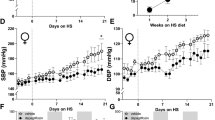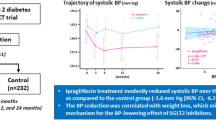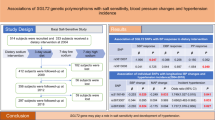Abstract
Sodium-glucose cotransporter 2 (SGLT2) inhibitors increase urine volume with glucosuria and natriuresis. We recently reported that osmotic diuresis by the SGLT2 inhibitor ipragliflozin induces fluid homeostatic action via the stimulation of fluid intake and vasopressin-induced water reabsorption in euvolemic rats. However, the effects of SGLT2 inhibitors on these parameters in hypervolemic animals remain unclear. In this study, Dahl salt-sensitive hypertensive rats, a hypervolemic rat model, were fed a low-salt (0.3%) or high-salt (8%) diet for 14 days, then divided into vehicle or ipragliflozin (0.01%) groups. During 7 days of treatment, the high-salt diet groups significantly increased fluid intake and urine volume. In the ipragliflozin groups, fluid intake and urine volume increased by 63% and 235%, respectively, in rats fed a normal-salt diet and by 46% and 72%, respectively, in rats fed a high-salt diet. Ipragliflozin increased urinary vasopressin by 200% and solute-free water reabsorption by 196% in the normal-salt group but by only 44% and 38%, respectively, in the high-salt group. A high-salt diet significantly increased fluid balance (fluid intake – urine volume) and Na+ balance (Na+ intake – urinary Na+), but ipragliflozin did not change fluid and Na+ balance in normal- or high-salt groups. A high-salt diet significantly increased systolic blood pressure, but ipragliflozin did not significantly change systolic blood pressure in normal- or high-salt groups. In conclusion, SGLT2 inhibitor ipragliflozin did not change fluid and Na+ balance regardless of basal fluid retention, suggesting the potential of SGLT2 inhibitors to maintain body water and Na+.

This is a preview of subscription content, access via your institution
Access options
Subscribe to this journal
Receive 12 print issues and online access
269,00 € per year
only 22,42 € per issue
Buy this article
- Purchase on SpringerLink
- Instant access to full article PDF
Prices may be subject to local taxes which are calculated during checkout








Similar content being viewed by others
References
Vallon V, Verma S. Effects of SGLT2 inhibitors on kidney and cardiovascular function. Annu Rev Physiol. 2021;83:503–28.
Vallon V. How can inhibition of glucose and sodium transport in the early proximal tubule protect the cardiorenal system? Nephrol Dial Transpl. 2024;4:gfae060.
Nuffield Department of Population Health Renal Studies G, Consortium SiM-AC-RT. Impact of diabetes on the effects of sodium glucose co-transporter-2 inhibitors on kidney outcomes: collaborative meta-analysis of large placebo-controlled trials. Lancet. 2022;400:1788–801.
Vallon V. State-of-the-art-review Mechanisms of action of SGLT2 inhibitors and clinical implications. Am J Hypertens. 2024;17:hpae092.
Masuda T, Nagata D. Fluid homeostasis induced by sodium-glucose cotransporter 2 inhibitors: novel insight for better cardio-renal outcomes in chronic kidney disease. Hypertens Res. 2023;46:1195–201.
Asakura-Kinoshita M, Masuda T, Oka K, Ohara K, Miura M, Morinari M, et al. Sodium-glucose cotransporter 2 inhibitor combined with conventional diuretics ameliorate body fluid retention without excessive plasma volume reduction. Diagnostics (Basel). 2024;14:1194.
Oka K, Masuda T, Ohara K, Miura M, Morinari M, Misawa K, et al. Fluid homeostatic action of dapagliflozin in patients with chronic kidney disease: the DAPA-BODY Trial. Front Med (Lausanne). 2023;10:1287066.
Masuda T, Ohara K, Vallon V, Nagata D. SGLT2 inhibitor and loop diuretic induce different vasopressin and fluid homeostatic responses in nondiabetic rats. Am J Physiol Ren Physiol. 2022;323:F361–F369.
Ohara K, Masuda T, Morinari M, Okada M, Miki A, Nakagawa S, et al. The extracellular volume status predicts body fluid response to SGLT2 inhibitor dapagliflozin in diabetic kidney disease. Diabetol Metab Syndr. 2020;12:37.
Masuda T, Muto S, Fukuda K, Watanabe M, Ohara K, Koepsell H, et al. Osmotic diuresis by SGLT2 inhibition stimulates vasopressin-induced water reabsorption to maintain body fluid volume. Physiol Rep. 2020;8:e14360.
Masuda T, Watanabe Y, Fukuda K, Watanabe M, Onishi A, Ohara K, et al. Unmasking a sustained negative effect of SGLT2 inhibition on body fluid volume in the rat. Am J Physiol Ren Physiol. 2018;315:F653–F664.
Schork A, Saynisch J, Vosseler A, Jaghutriz BA, Heyne N, Peter A, et al. Effect of SGLT2 inhibitors on body composition, fluid status and renin-angiotensin-aldosterone system in type 2 diabetes: a prospective study using bioimpedance spectroscopy. Cardiovasc Diabetol. 2019;18:46.
Heusser K, Tank J, Diedrich A, Fischer A, Heise T, Jordan J. Randomized trial comparing SGLT2 inhibition and hydrochlorothiazide on sympathetic traffic in type 2 diabetes. Kidney Int Rep. 2023;8:2254–64.
Huang X, Dorhout Mees E, Vos P, Hamza S, Braam B. Everything we always wanted to know about furosemide but were afraid to ask. Am J Physiol Ren Physiol. 2016;310:F958–971.
Greene AS, Yu ZY, Roman RJ, Cowley AW Jr. Role of blood volume expansion in Dahl rat model of hypertension. Am J Physiol. 1990;258:H508–514.
Masuda T, Muto S, Fujisawa G, Iwazu Y, Kimura M, Kobayashi T, et al. Heart angiotensin II-induced cardiomyocyte hypertrophy suppresses coronary angiogenesis and progresses diabetic cardiomyopathy. Am J Physiol Heart Circ Physiol. 2012;302:H1871–1883.
Masuda T, Fu Y, Eguchi A, Czogalla J, Rose MA, Kuczkowski A, et al. Dipeptidyl peptidase IV inhibitor lowers PPARgamma agonist-induced body weight gain by affecting food intake, fat mass, and beige/brown fat but not fluid retention. Am J Physiol Endocrinol Metab. 2014;306:E388–398.
Onaka T, Hamamura M, Yagi K. Potentiation of vasopressin secretion by footshocks in rats. Jpn J Physiol. 1986;36:1253–60.
Nagasawa K, Takahashi K, Matsuura N, Takatsu M, Hattori T, Watanabe S, et al. Comparative effects of valsartan in combination with cilnidipine or amlodipine on cardiac remodeling and diastolic dysfunction in Dahl salt-sensitive rats. Hypertens Res. 2015;38:39–47.
Shimizu K, Kurosawa T, Sanjo T. Effect of hyperosmolality on vasopressin secretion in intradialytic hypotension: a mechanistic study. Am J Kidney Dis. 2008;52:294–304.
Onishi A, Fu Y, Patel R, Darshi M, Crespo-Masip M, Huang W, et al. A role for tubular Na(+)/H(+) exchanger NHE3 in the natriuretic effect of the SGLT2 inhibitor empagliflozin. Am J Physiol Ren Physiol. 2020;319:F712–F728.
Mahon WA, Holland J, Urowitz MB. Hyperosmolar, non-ketotic diabetic coma. Can Med Assoc J. 1968;99:1090–2.
Zerbe RL, Robertson GL. Osmoregulation of thirst and vasopressin secretion in human subjects: effect of various solutes. Am J Physiol. 1983;244:E607–614.
Sladek CD, Knigge KM. Osmotic control of vasopressin release by rat hypothalamo-neurohypophyseal explants in organ culture. Endocrinology. 1977;101:1834–8.
Kravtsova O, Bohovyk R, Levchenko V, Palygin O, Klemens CA, Rieg T, et al. SGLT2 inhibition effect on salt-induced hypertension, RAAS, and Na(+) transport in Dahl SS rats. Am J Physiol Ren Physiol. 2022;322:F692–F707.
Kravtsova O, Levchenko V, Klemens CA, Rieg T, Liu R, Staruschenko A. Effect of SGLT2 inhibition on salt-induced hypertension in female Dahl SS rats. Sci Rep. 2023;13:19231.
Daniels LB, Maisel AS. Natriuretic peptides. J Am Coll Cardiol. 2007;50:2357–68.
Oka T, Sakaguchi Y, Hattori K, Asahina Y, Kajimoto S, McCallum W, et al. Association of Longitudinal B-Type Natriuretic Peptide Monitoring With Kidney Failure in Patients With CKD: A Cohort Study. Am J Kidney Dis. 2023;82:559–68.
Morgenthaler NG, Struck J, Alonso C, Bergmann A. Assay for the measurement of copeptin, a stable peptide derived from the precursor of vasopressin. Clin Chem. 2006;52:112–9.
Fitzsimmons MD, Roberts MM, Robinson AG. Control of posterior pituitary vasopressin content: implications for the regulation of the vasopressin gene. Endocrinology. 1994;134:1874–8.
Packer M. Critical reanalysis of the mechanisms underlying the cardiorenal benefits of SGLT2 inhibitors and reaffirmation of the nutrient deprivation signaling/autophagy hypothesis. Circulation. 2022;146:1383–405.
Packer M. Lack of durable natriuresis and objective decongestion following SGLT2 inhibition in randomized controlled trials of patients with heart failure. Cardiovasc Diabetol. 2023;22:197.
Packer M. SGLT2 inhibition: neither a diuretic nor a natriuretic. J Am Coll Cardiol. 2024;83:1399–402.
Marton A, Saffari SE, Rauh M, Sun RN, Nagel AM, Linz P, et al. Water conservation overrides osmotic diuresis during SGLT2 inhibition in patients with heart failure. J Am Coll Cardiol. 2024;83:1386–98.
Pool AH, Wang T, Stafford DA, Chance RK, Lee S, Ngai J, et al. The cellular basis of distinct thirst modalities. Nature. 2020;588:112–7.
Layton AT, Vallon V. SGLT2 inhibition in a kidney with reduced nephron number: modeling and analysis of solute transport and metabolism. Am J Physiol Ren Physiol. 2018;314:F969–F984.
Bahena-Lopez JP, Rojas-Vega L, Chavez-Canales M, Bazua-Valenti S, Bautista-Perez R, Lee JH, et al. Glucose/fructose delivery to the distal nephron activates the sodium-chloride cotransporter via the calcium-sensing receptor. J Am Soc Nephrol. 2023;34:55–72.
Castro PC, Santos-Rios TM, Martins FL, Crajoinas RO, Caetano MV, Lessa LMA, et al. Renal upregulation of NCC counteracts empagliflozin-mediated NHE3 inhibition in normotensive but not in hypertensive male rat. Am J Physiol Cell Physiol. 2024;326:C1573–C1589.
Haque MZ, Ares GR, Caceres PS, Ortiz PA. High salt differentially regulates surface NKCC2 expression in thick ascending limbs of Dahl salt-sensitive and salt-resistant rats. Am J Physiol Ren Physiol. 2011;300:F1096–1104.
Acknowledgements
The authors acknowledge the technical support provided by Mihoko Sejimo, Keiko Fukuda, Minami Watanabe, and Mamiko Watanabe (Division of Nephrology, Department of Internal Medicine, Jichi Medical University). We would like to thank Editage (www.editage.jp) for English language editing. This study was supported in part by the Manpei Suzuki Diabetes Foundation No. 32436025 (to T.M.), the Jichi Medical University Young Investigator Award (to T. M.), Salt Science Research Foundation No. 2232 (to T. M.), and a Grant-in-Aid for Young Scientists No. 15K21321 (to T. M.).
Author information
Authors and Affiliations
Contributions
T.M. conceived and designed the research, performed the experiments, analyzed the data, prepared the figures, and drafted the manuscript. M.Y. performed the experiments, analyzed the data, and drafted the manuscript. T.M., M.Y., and T.O. interpreted the results of the experiments; T.M., M.Y., T.O, and D.N. edited and revised the manuscript; T.M., M.Y., T.O., and D.N. approved the final version of the manuscript.
Corresponding author
Ethics declarations
Conflict of interest
Astellas Pharma (Tokyo, Japan) provided SGLT2 inhibitor ipragliflozin for this study.
Additional information
Publisher’s note Springer Nature remains neutral with regard to jurisdictional claims in published maps and institutional affiliations.
Rights and permissions
Springer Nature or its licensor (e.g. a society or other partner) holds exclusive rights to this article under a publishing agreement with the author(s) or other rightsholder(s); author self-archiving of the accepted manuscript version of this article is solely governed by the terms of such publishing agreement and applicable law.
About this article
Cite this article
Masuda, T., Yoshida, M., Onaka, T. et al. Water and sodium conservation response induced by SGLT2 inhibitor ipragliflozin in Dahl salt-sensitive hypertensive rats. Hypertens Res 47, 3173–3181 (2024). https://doi.org/10.1038/s41440-024-01893-3
Received:
Revised:
Accepted:
Published:
Issue Date:
DOI: https://doi.org/10.1038/s41440-024-01893-3
Keywords
This article is cited by
-
Glomerular pressure and tubular oxygen supply: a critical dual target for renal protection
Hypertension Research (2024)



